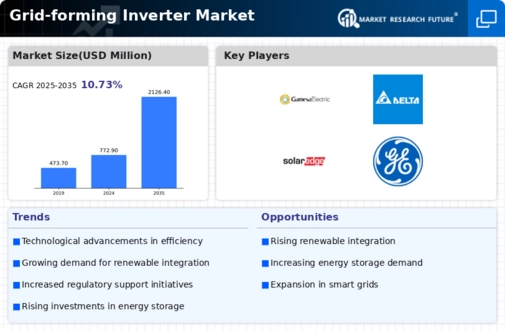Major market players are spending a lot of money on R&D to increase their product lines, which will help the Grid-forming Inverter Market grow even more. Market participants are also taking a range of strategic initiatives to grow their worldwide footprint, including new product launches, contractual agreements, mergers and acquisitions, increased investments, and collaboration with other organizations. Competitors in the Grid-forming Inverter Market industry must offer cost-effective products to expand and survive in an increasingly competitive and rising market environment.
One of the primary business strategies adopted by manufacturers in the global Grid-forming Inverter industry to benefit clients and expand the Grid-forming Inverter market sector is to manufacture locally to reduce operating costs. The market for Grid-forming Inverter is recognized as being extremely competitive and fragmented. The market for Grid-forming Inverter offers considerable potential opportunities for domestic and unorganised companies.
Some of the key players operating in the Grid-forming Inverter Market are Huawei Technologies Co., Ltd, SMA Solar Technology AG, Gamesa Electric, Fimer Group , Delta Electronics, Inc, Solectria Solar, ABB, SolarEdge Technologies Inc, General Electric and Sineng Electric Co Ltd. To increase their global reach and client base, key firms are concentrating on acquisitions and product innovation.
Huawei Technologies Co Ltd (Huawei), a subsidiary of Huawei Investment & Holding Co Ltd, is a provider of information and communication technology (ICT) infrastructure and smart devices. The company’s product portfolio includes laptops, tablets, routers, wearables, headphones, enterprise wireless products, enterprise optical transmission and access products, networking products, cloud and computing products. It also offers services and software for carrier networks, and smart services for enterprises. Huawei serves education, finance, healthcare, internet services providers, manufacturing, oil and gas, public safety, retail, smart city, smart grid, and transportation industry.
Huawei Technologies Co. Ltd. (China) a leading global technology company, has been actively involved in the development and deployment of grid-forming inverters for renewable energy integration and grid modernization. Huawei's grid-forming inverter business offers advanced solutions that enable the stable integration of renewable energy sources into electricity grids and provide grid support services. The company has business presence across the Americas, Africa, Europe, and Asia-Pacific. Huawei is headquartered in Shenzhen, Guangdong, China.
General Electric Co (GE) : is an industrial conglomerate. It provides a range of industrial, infrastructure and financial products and services. The company offers a wide range of products and services from aircraft engines and systems, healthcare systems and pharmaceutical diagnostics, power generation, and oil and gas production equipment to medical imaging, financing and industrial products. It also offers a comprehensive range of financial services to its customers. The company serves water, oil and gas, power, energy management, aviation, healthcare, digital, transportation, appliances and lighting industries, among others.
It has operations in North America, Europe, Asia, the Middle East, and Africa and other regions; and has manufacturing facilities across the world. GE is headquartered in Boston, Massachusetts, the US..















Leave a Comment